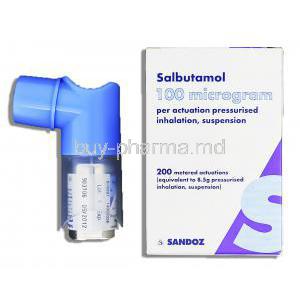Salbutamol Inhaler
Introduction
What is a Salbutamol Inhaler, and Why is it Important?
Salbutamol inhalers3, also known as "rescue inhalers," are medical devices designed for the quick administration of Salbutamol—a medication that helps relax the muscles in the airways, improving airflow. In the field of medicine, Salbutamol inhalers play a crucial role.
Brief Overview of Asthma and Other Respiratory Conditions
Asthma is a manageable respiratory condition characterized by recurring inflammation and narrowing of the airways. Similarly, Chronic Obstructive Pulmonary Disease (COPD) is another condition that affects respiratory function. Both conditions can have health risks.
Scope of the Article: What Will You Learn?
This article aims to analyze the various uses of Salbutamol inhalers. It covers their application in known conditions like Asthma and COPD and explores lesser-known or off-label uses such as Hyperkalemia (high potassium levels) and Preterm Labor.
Uses of Salbutamol Inhaler
Treatment of Asthma: Quick Relief vs. Long-Term Management
- Quick relief refers to the alleviation of symptoms during acute exacerbations. By dilating the airways, Salbutamol provides a temporary respite from distressing symptoms.
- While it is not a replacement for corticosteroids or other long-term medications, Salbutamol is sometimes included in treatment plans due to its rapid bronchodilatory effects.
Chronic Obstructive Pulmonary Disease (COPD): How Salbutamol Helps
Salbutamol also plays a role in improving the symptoms of Chronic Obstructive Pulmonary Disease (COPD)1. Reducing bronchospasm and improving the caliber of passages significantly enhances the quality of life for individuals with COPD.
Exercise-Induced Bronchoconstriction: A Preventative Measure
Salbutamol can be used as a preventive measure for athletes or individuals prone to bronchoconstriction during exertion. By using an inhaler before engaging in activities, one can avoid respiratory distress that may occur as a result. In addition to its use in managing respiratory conditions
Off-Label Uses: Cases Where Salbutamol May Be Prescribed
Salbutamol has been prescribed off-label for other purposes, such as stabilizing blood CO2 levels during acute hypercapnia episodes, acting as an adjunct to epinephrine in anaphylactic reactions, and reducing high potassium levels (hyperkalemia). It is interesting to note that Salbutamol also contributes to maintaining potassium homeostasis. By activating the beta 2 receptors
Hyperkalemia: How Salbutamol Lowers High Potassium Levels
Salbutamol helps move potassium ions inside cells, alleviating high serum potassium levels, known as hyperkalemia.
Preterm Labor: Controversial but Potential Use
The ability of Salbutamol to relax the uterus has prompted its investigation as a treatment for preterm labor. However, its use in this context is still under scrutiny within the community and subject to ongoing ethical discussions.
How Salbutamol Works
The Mechanism of Action: Understanding Agonists
Salbutamol works as a specific type of bronchodilator called a selective beta 2 adrenergic receptor agonist. It binds to receptors on the bronchial tubes' muscle cells, triggering cellular events. These events ultimately lead to the relaxation of the muscles in the airways. The way Salbutamol achieves this is quite fascinating. Has contributed to its wide use in clinical settings.

How Salbutamol Relieves Airway Muscle Tension
When Salbutamol binds to its receptors, it activates an adenyl cyclase enzyme. This enzyme plays a role in converting adenosine triphosphate (ATP) into cyclic adenosine monophosphate (cAMP)2. Increased levels of cAMP have effects;
- Relaxation of the muscles in the airways.
- Inhibition of mast cell degranulation.
- Improved clearance of mucus through cilia movement.
These combined effects promote airflow, providing relief from respiratory distress.
Onset and Duration of Salbutamols Effects
Salbutamol starts working quickly, usually within 5 to 20 minutes after administration. Its therapeutic effects typically last for around 4 to 6 hours, making it an excellent choice for relieving symptoms rather than long-term management.
Dosage and Administration
The recommended dosage for relief from asthma symptoms typically ranges from 100 to 200 micrograms per inhalation. Physicians often advise the following:
- Take one puff for symptoms
- Take two puffs for exacerbations

For patients with Chronic Obstructive Pulmonary Disease (COPD) or conditions the dosage regimen is usually similar to that recommended for asthma. However, it is crucial to consult a healthcare provider for recommendations.
To ensure the effectiveness of the medication it is essential to follow proper inhalation techniques:
- Shake the inhaler vigorously before using it
- Completely exhale before inhaling
- If available use a spacer device
Avoiding mistakes can help maintain the effectiveness of a salbutamol inhaler. These include:
- Not shaking the inhaler before use
- Failing to synchronize actuation and inhalation correctly.
- Not maintaining a sealed lip seal, around the mouthpiece.
Composition of Salbutamol Inhaler
The active ingredient in Salbutamol inhalers is called Salbutamol. The inactive components, such as propellants and surfactants, vary depending on the type of inhaler. They are used to control the spray characteristics or stabilize the formulation.

There are two types of Salbutamol inhalers:
- Hydrofluoroalkane (HFA) inhalers, which are friendly and widely used
- Chlorofluorocarbon (CFC) inhalers, which have become mostly obsolete due to environmental concerns
Strict quality control measures are implemented to ensure the safety, effectiveness, and consistency of Salbutamol inhalers. These measures include testing for the quantification of the ingredient, assessing aerodynamic particle size distribution, and checking for microbial contamination.
Side Effects of Salbutamol
Side Effects: What to Expect
It's not uncommon for medications to come with some unwanted effects, and Salbutamol is no different. The commonly reported side effects include:
- Mild headaches
- Feeling dizzy or lightheaded
- Experiencing dryness in the mouth or irritation in the throat
Fortunately, these side effects often diminish as your body gets used to the medication.

Tremors, Nervousness, Increased Heart Rate
Salbutamol interacts with receptors in the body's nervous system, which can sometimes lead to tremors and feelings of nervousness. Additionally, the DTS effect on sympathomimetic activity may cause palpitations and an increased heart rate4. While these effects can be unsettling, they usually don't last long.
Rare but Serious Side Effects
In some cases, Salbutamol may cause more severe side effects, such as:
- Hypokalemia (low potassium levels)
- Hyperglycemia (high blood sugar levels)
- Metabolic acidosis (an imbalance in the body's acid-base levels)
If you experience chest pain, which could indicate involvement of your cardiovascular system, it's crucial to seek immediate medical attention. Similarly infrequent but important are reactions that could potentially escalate into anaphylactic shock – a life-threatening condition.
Strategies for Managing Side Effects
Managing side effects2 should be approached from angles and may include:
- Stopping medication immediately if severe reactions occur
- Consulting healthcare professionals for relief from symptoms
- Adjusting dosage or exploring alternative therapies if persistent issues arise
Warnings and Contraindications
When it comes to using Salbutamol, there are situations where it should be avoided. These include cases where a person is hypersensitive to the drug or its components and specific cardiac conditions such as tachyarrhythmias.
It's essential to be cautious about drug interactions that can affect the effectiveness of Salbutamol or worsen its side effects. Some examples of medications that could have interactions are
- Beta-blockers
- Diuretics
- Certain antidepressants like MAOIs.
Furthermore, some conditions may limit the use of Salbutamol, such as
- Uncontrolled hypertension
- Specific forms of heart disease
- Hyperthyroidism.
Careful Administration and Important Precautions
Monitoring heart rate and blood pressure is crucial for individuals with existing heart conditions. It is essential to monitor these cardiovascular parameters.
While Salbutamol is intended to alleviate bronchoconstriction, there are cases where it can paradoxically trigger bronchospasm. If such episodes occur, immediate discontinuation of the medication and alternative treatment protocols are necessary.
To safely discontinue the use of Salbutamol, it is advised to taper the dosage under medical supervision. Abruptly stopping the medication can result in withdrawal symptoms. Worsen respiratory distress.
Special Populations
For patients, it is essential to consider potential adjustments in the dosage of Salbutamol due to changes in its pharmacokinetic properties.
Elderly individuals may have heightened sensitivity, especially regarding side effects like
- Hypertension
- Arrhythmias
Given that these patients have other health conditions, it is crucial to exercise extreme caution when managing their medication.
Regarding women and nursing mothers, it is essential to understand that pregnancy and lactation can bring about various metabolic and physiological changes that might impact how Salbutamol works in the body. While the FDA categorizes this medication as Pregnancy Category C, meaning there are risks but no definitive human studies, a careful risk-benefit analysis should be conducted.
Regarding children, Salbutamol is generally not recommended for those under the age of four. It is essential to pay attention when administering this medication to pediatric patients due to the
- Risks of exacerbating hyperactivity
- The possibility of incorrect administration techniques
For this group, therapeutic vigilance and appropriate dosage adjustments based on age are crucial.
Overdosage and Handling Precautions
Signs of taking too much Salbutamol
If you take an excessive amount of Salbutamol, it can lead to various systemic complications, such as:
- Rapid heartbeat (tachycardia)
- High blood sugar levels (hyperglycemia)
- Muscle tremors
In such cases, seeking immediate medical attention and appropriate treatment is crucial.

Immediate actions for managing an overdose
If there is a suspicion of an overdose, it is essential to seek medical help. Some basic supportive measures that may be taken include:
- Providing oxygen therapy
- Administering fluids
- Monitoring the heart's electrical activity through electrocardiography
Precautions for storing and handling Salbutamol inhalers
Proper storage and handling of Salbutamol inhalers are vital for maintaining their effectiveness. Users should take the following precautions:
- Avoid exposing the inhaler to temperatures
- Keep the canister away from moisture
Storage and Stability
The longevity of Salbutamol
It depends on storing it in conditions typically at room temperature, away from direct light and heat.

The integrity of a Salbutamol inhaler
Over time, there are factors to consider. These include:
- Changes in the consistency of the aerosol
- Any alterations in taste or smell
- Decrease in its effectiveness in relieving symptoms
If you notice any indications of compromise with the product, it is essential to replace it immediately.













































